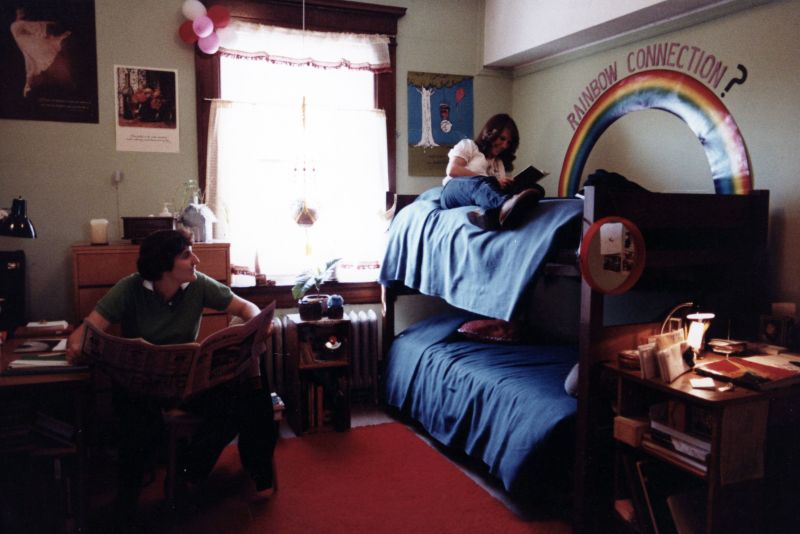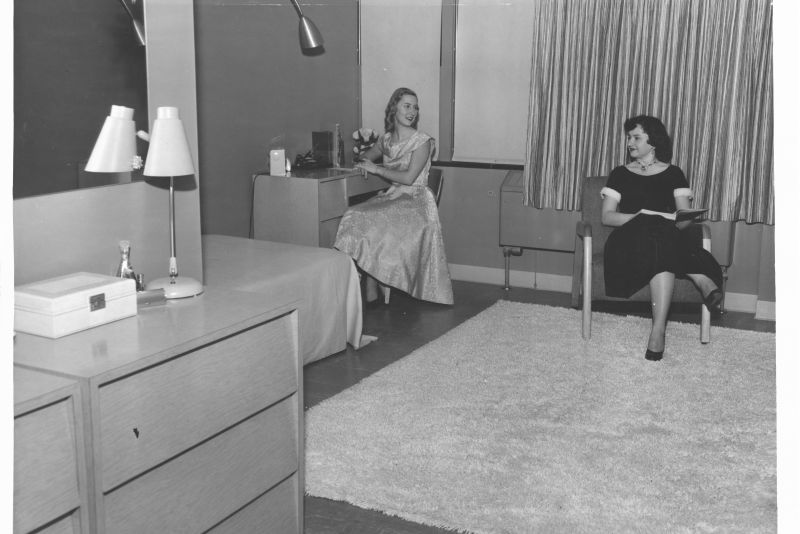The St. Kate's Library & Archives will be closed from Dec 20 - Jan 4. Interlibrary Loan (ILL) requests for physical items (print books & DVDs) will not be filled during this period. You can still access help and resources online.
Residence Hall History
Students at St. Kate’s have lived on the campus since the college first opened in 1905, but the buildings they’ve lived in have changed throughout the century. The Archives and Special Collections exhibit in the CdC atrium takes a look at some of these changes.
When St. Kate’s first opened, all the students lived on the top level of Derham Hall, the only building on campus. As the campus population grew so did the need for housing. A second building, Whitby Hall (known as College Hall until 1929) was opened in 1914. Caecilian Hall followed in 1921. Over the next 80+ years the campus, and student housing, would continue to grow.
Many of the oldest buildings on campus served multiple purposes, including housing. While Whitby was primarily built to house students, it also included the art and science departments, the Jeanne d’Arc Auditorium, and at one time, a gymnasium and parlor. Classroom and office use of the building slowly grew, and the last students moved out of Whitby in 2012. Caecilian Hall was constructed to be a music building but due to the rising need for housing on campus, the upper floors were quickly converted into dorm rooms. By 1970 the entire building had been renovated for housing. Students even lived on the fourth floor of St. Joseph Hall, the student center, until 2002 when it was incorporated into the Coeur de Catherine.
Built 1960, St. Mary Hall was the first building on campus to exist solely for the purpose of housing students. But resident students kept increasing and in the late 1960s St. Kate’s faced a campus housing shortage. To remedy this, nine trailers were placed south of Fontbonne Hall. This “Campus Court” housed 70 students during the 1967-68 school year until Crandall and Stanton Halls were built. Enrollment increased again in 1974, leaving 45 students to live in Mary Hall, a residence connected to St. Joseph Hospital in St. Paul. Fortunately, with the construction of Rauenhorst and Morrison in 2007, there’s now no shortage of places to live on campus.
If you would like more information about how St. Catherine expanded over time or other history of the University, please visit us in the lower level of the library. We're open Monday-Friday, 9:30-4:30. Our Archives and Special Collections are also available on the St. Catherine University library website.

Many of the oldest buildings on campus served multiple purposes, including housing. While Whitby was primarily built to house students, it also included the art and science departments, the Jeanne d’Arc Auditorium, and at one time, a gymnasium and parlor. Classroom and office use of the building slowly grew, and the last students moved out of Whitby in 2012. Caecilian Hall was constructed to be a music building but due to the rising need for housing on campus, the upper floors were quickly converted into dorm rooms. By 1970 the entire building had been renovated for housing. Students even lived on the fourth floor of St. Joseph Hall, the student center, until 2002 when it was incorporated into the Coeur de Catherine.

Built 1960, St. Mary Hall was the first building on campus to exist solely for the purpose of housing students. But resident students kept increasing and in the late 1960s St. Kate’s faced a campus housing shortage. To remedy this, nine trailers were placed south of Fontbonne Hall. This “Campus Court” housed 70 students during the 1967-68 school year until Crandall and Stanton Halls were built. Enrollment increased again in 1974, leaving 45 students to live in Mary Hall, a residence connected to St. Joseph Hospital in St. Paul. Fortunately, with the construction of Rauenhorst and Morrison in 2007, there’s now no shortage of places to live on campus.

If you would like more information about how St. Catherine expanded over time or other history of the University, please visit us in the lower level of the library. We're open Monday-Friday, 9:30-4:30. Our Archives and Special Collections are also available on the St. Catherine University library website.